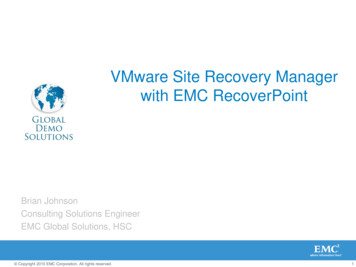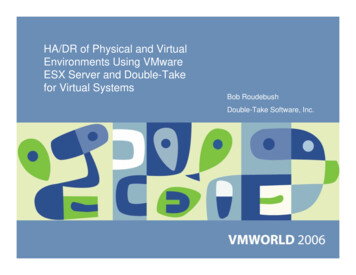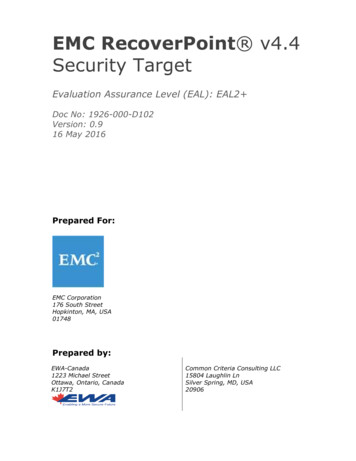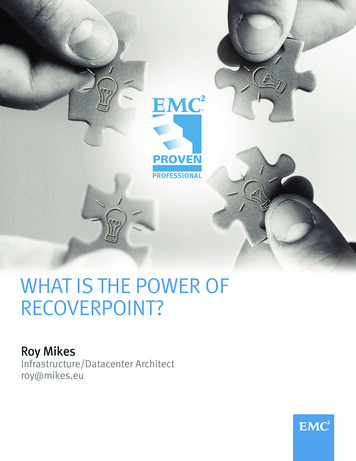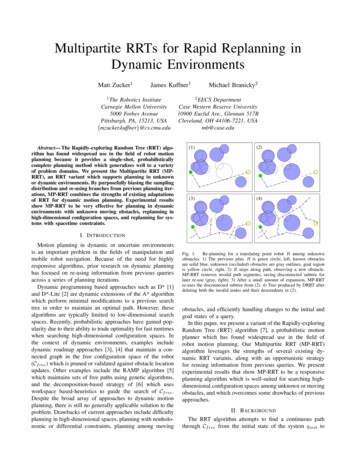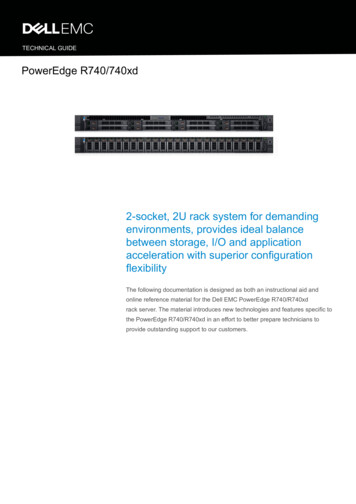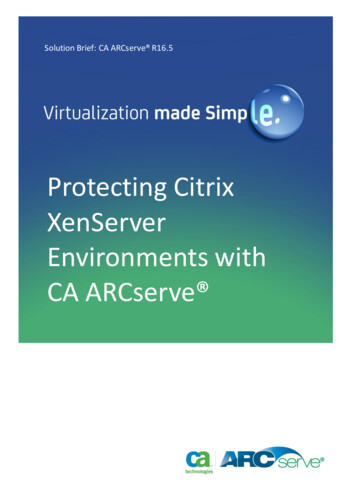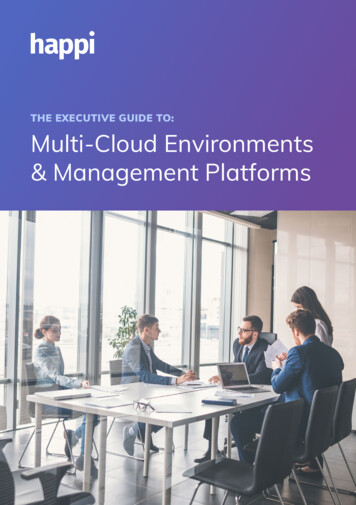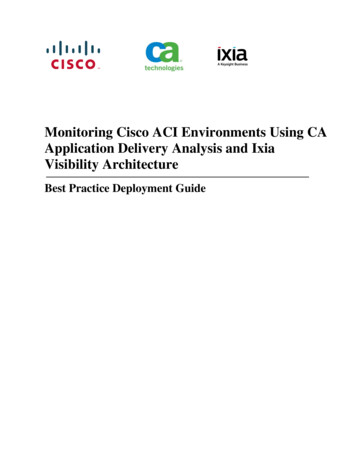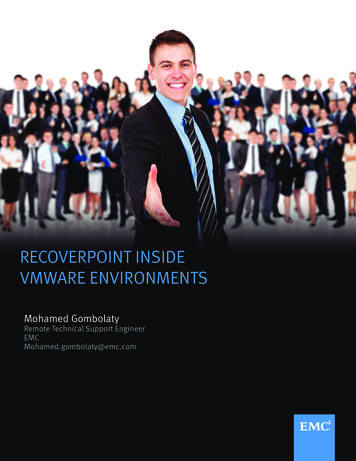
Transcription
RECOVERPOINT INSIDEVMWARE ENVIRONMENTSMohamed GombolatyRemote Technical Support EngineerEMCMohamed.gombolaty@emc.com
Table of ContentsIntroduction . 3Why RecoverPoint is smart Replication . 6Block-Level Replication . 6Any Point in Time. 7Estimated Protected Period . 8Consistency Groups and Group Sets . 9Replicating over IP and FC, locally and/or remotely . 9API and Scripting . 9RecoverPoint and VMware . 10RecoverPoint topologies in VMware . 10Classic Physical RP deployment . 10Virtual RecoverPoint Deployment . 11RecoverPoint for VM . 11Design Considerations . 14Network . 14Resources . 15Incoming writes . 16Journal Sizes . 17Conclusion . 18Disclaimer: The views, processes or methodologies published in this article are those ofthe author. They do not necessarily reflect EMC Corporation’s views, processes ormethodologies.2015 EMC Proven Professional Knowledge Sharing2
IntroductionIn July 2014, Gartner released its x86 Virtualized Server Magic Quadrant whichestimated 70% of x86 servers are now virtualized, with VMware the leading vendor(https://www.gartner.com/doc/2788024?srcId 1-2819006590&pcp itg). By now, most ofyou have a virtualized environment and most probably you are using VMware.But with virtualization comes new challenges. While basic IT operations, such asmonitoring, backup, and replication still need to be performed, they need to be done in adifferent manner to accommodate virtualization concepts and operations.Replicating a virtual environment has been quite a challenge. In our experience we havefound many common challenges. First, let’s re-visit why replication is important. Thenotes below were inspired by the following link which discusses the need to spend onreplication technology for virtual environments -webinar):70% of reported DC outages are directly attributable to human error.” Source:Uptime Institute, Data Center Site Infrastructure Tier Standard: OperationalSustainability, 2010. No recent reports on if that number has changed withautomation being used, but for example a complete French Government systemwas down for four days due to a sub-contractor accidently triggering -days/)Though many believe that backup alone will make them safe, it didn’t happen thein French government example. Using replication will minimize downtime even ifbackups will work, the easier and more resilient your replication tool is will savemoney lost with every second of downtime. A Gartner blog discussion states anaverageof ime/).(http://blogs.gartner.com/andrewYou can calculate your own costfollowing Gartner Toolkit: Downtime Cost Calculator for Data Center DisasterRecovery Planning (Robert Naegle) (http://www.gartner.com/document/2674021)2015 EMC Proven Professional Knowledge Sharing3
When working with disasters or outages you need to be aware of two majorconcepts:RPO (Recovery Point of Objective): RPO simply means the data you willbring back up whether on the Source or DR side, how far back will it be,i.e. will it be 15 minutes before a disaster occurred or 30 minutes, anhour, or more. The further back, the more data loss you will face, whichwill add up to your downtime cost. Thus, ensure you have lowest RPOpossible.RTO (Recovery Time Objective): this indicator is how much time youneed to bring production servers back up serving customers from the datayou replicated or backed up. Replication is much faster since they tend toupdate DR resources with the latest unlike Backups which will need moretime to restore data on disks.Those two combined are your compass when in downtime, disaster recovery, orcorruption recovery situations. The lower both are, the more efficient you are inhandling outages.Picture from community.emc.com.Now, let’s move to the challenges facing VM replication. You need to consider thefollowing points:Complexity: You certainly have a lot to consider. Since these VMs share ESXservers, you must be very keen on deciding to do it on a VM (normally calledGuest Level) or on an ESX level and weight the overhead of backup orreplication on ESX resources. Additionally, you must be sure to replicate all dataneeded to bring VM up correctly on DR or to restore it. For example, you can2015 EMC Proven Professional Knowledge Sharing4
replicate the correct LUNs but still fail to bring the VM up because you didn’treplicate or back up the snapshot data directory. Another consideration is howfrequently can you replicate or backup and also test the solution withoutdowntime or affecting production. All these questions require answers.Scalability: Once you have decided how to replicate, how much can it scale asyour environment grows? You need to know how long you can survive with yourinfrastructure until you need to add more investment. Certainly, the longer thebetter. Again, this depends on the replication method and technology youchoose.Meeting Expectations: Since you invested in replication, you are expected toachieve RPO and RTO. Thus, you need to keep making sure you can meet theserequirements from the technology you used, or from frequent testing. This willhelp ensure that your staff and your replication technology can achieve targets,and be notified if any part still needs to be fine-tuned. It’s worth mentioning thatDisaster Recovery is not about software and hardware only; it is more of aHolistic operation that involves people, procedures, and technology. You need toensure you can meet targets whether it be for performance overall in the processof actual failing over or recovery or also when not in need for a failover orrecovery.Cost: A solution that offers RPO of zero and RTO of zero as well will certainlybe expensive and you might not be able to afford it. Even if you can, your RTOneeds may not require zero time. Maybe 15 minutes would be the same and anRPO of 5 minutess will also be OK with management. Thus, you may need tothink about cost vs RPO and RTO combined and increase it to lower numberslater from an RPO point of view. Start simply with a solution that can grow withyou.The remainder of this article will showcase how RecoverPoint as a replicationtechnology works inside your VMware environment, enables you to achieve the bestRPO and RTO times, scales as your environment grows, and ensures you will meet yourreplication targets and test as frequently as you want.2015 EMC Proven Professional Knowledge Sharing5
Why RecoverPoint is smart ReplicationRecoverPoint’s replication technology has a lot of unique features that make it avaluable resource in a data center. RP4VM, released in November 2014, is a tool awareof its virtual existence and provides administrators with remarkable power options.Let’s examine and explain RecoverPoint piece by piece.Starting as software installed on a specifically designed U-Server, RecoverPoint cannow be deployed as an OVF. What sets it apart is the code and theory of operation; hereare some points that make RecoverPoint an efficient replication tool:Block-Level ReplicationRecoverPoint requires either FC or ISCSI access to storage, depending on topologyused. Because RecoverPoint works on a block level it only understands 0s and 1s,which means that RecoverPoint need not understand your OS or application. Whateverit is, RecoverPoint will be able to provide a crash-consistent image of the LUN at a pointin time you desire, so it’s a unified replication for any OS or File system type. Thus,Windows, AIX, Solaris, and all Linux flavors can be replicated with the same replicationtool and provide a crash-consistent image which means this is the LUN with the exact0s and 1s at the point in time you choose. Application level might not be consistent,especially with databases. This is because to consider an image consistent, a DBnormally expects writes to database data and redo log data is done. However, yourimage might have the write completed to the data database but not to the redo-log.Thus, database conceives it as inconsistent. Now those errors can be resolved from thedatabase itself. Probably, it will discard transactions not found in redo-log. A DB Admincan fix these errors or you can search from the wealth of images you can choose fromuntil you find an image application that is consistent. Normally, these images will be thelowest size when you search the images list. If you require application-consistentimages, you will find tools and procedures to periodically create bookmarks onapplication consistent images. They are very quick and don’t require putting your DB onhot-back up mode for long. If it is scripted well, it can take an average of 2 minutes topsin large environments.2015 EMC Proven Professional Knowledge Sharing6
Eventually, you will have a replication tool for any type of OS, and with simple tweaking,make it application consistent if necessary, though with the next point you might notconsider even trying to fine tune.Any Point in TimeRecoverPoint depends on having a mechanism in the environment – called a splitter –which has one function; to see packets moving between host and storage related toLUNs that RP has been configured to replicate. The reason that we care about packetswith write SCSI codes is because these packets will make a change on the LUN they aredestined for. Thus RecoverPoint must replicate that packet as well, so the splitter copiesthat write packet and makes the RP server the destination for the new copy packet. Toensure consistency, the host will not receive a write confirmation until the splitterreceives confirmation from both the Storage and RecoverPoint appliance. This isbecause if storage fails or RecoverPoint for any reason there will be no consistencybetween Source LUN and Replica LUN.While this splitter technology might seem intrusive, it’s not. It only cares about writes.Only reads are unharmed and reads are what most of I/O load is about. There is nodelay or higher latency. we have RecoverPoint working in data centers with large,complicated I/O loads and the splitter is not adding overhead to the process.A splitter now can be residing in one of the following: Storage: VNX and VMAX and VNXe all have RecoverPoint splittersembedded and only need an active license, suitable when Source LUNs areusing EMC Storage. VPLEX : if Source are on non-EMC storage, you can still replicate themusing VPLEX as a splitter. VPLEX will mask the LUNs from third-partystorage through it and do the splitting for RecoverPoint. ESX Splitter: Now in 5.5 Update 1, splitter software can be installed on ESX.This can work on any storage as long as traffic passes by the ESX servers itis installed on.You can see multiple options according to your specific topology, and you can mixdifferent splitters in the same site as well.2015 EMC Proven Professional Knowledge Sharing7
Perhaps the most Important value gained from the splitter is the ability to make imagesas the writes come. Even down to each write, an image can be made of it (SyncReplication) or group a number of writes into a single image (size or time). All of theseattributes can be controlled and specified if you wish. This is how detailed optionsempowers a customer to control his replication RPO.Many people describe the images they see on RecoverPoint like a Tevo TV backwardoption. You can go back second by second or write by write depending on replicationyou choose. This is the most trusted RPO decrease you can ever get or control.Estimated Protected PeriodThe difference between replication and backup is needed to keep images in yourpossession. Backups are mainly for long durations – months, maybe even years.Meanwhile, replication is short term – a day or a week. To bypass any suddenproduction downtimes or performance or corruption, you need to know how much timeyour replication can hold data for a LUN or a group of replicated LUNs. RecoverPointAppliances can estimate how much based on Incoming writes rate. This is possiblebecause RecoverPoint uses Journal LUNs dedicated to keeping the images. Based oncapacity of the journal with the incoming writes rate, RecoverPoint can quickly calculatethe predicted or estimated period it can keep, constantly changing with the incoming I/Orate. If you need more time, you can add more Journals.2015 EMC Proven Professional Knowledge Sharing8
Consistency Groups and Group SetsLogically, you always have a relationship between a number of LUNs or disks. Forexample, three disks consist or contain database information data and configuration, sologically you need your replication tool to be aware of that, and even accommodatehaving them replicated together and DR access to be done for them all at the same time.RecoverPoint achieves this by configuring LUNs into what resembles a Containernamed Consistency Group (CG). Each CG contains any number of replication sets, anda replication set consists of a source LUN and replica luns data.RecoverPoint will replicate any number of replication sets configured under oneconsistency and make sure that write fidelity order is maintained across them. Thisensures a crash consistent image across all these LUNs at that specific point of time.Not only can bookmarks of images be taken at the same time across a number ofdifferent CGs, being able to have an exact image across a number of CGs can bebeneficial if you want to subdivide LUNs in different CGs but need also to have aconsistent point of time across them. The frequency starts from 30 seconds and above.Replicating over IP and FC, locally and/or remotelyRecoverPoint can have local replication and/or remote replication. A Consistency Groupis not limited to just one of either local or remote. It can replicate locally and remotely atthe same time, and the remote copy can be more than 1. In RecoverPoint version 4.0onward you can have one source and four replicas maximum, and those 4 can be indifferent sites as well. Additionally, a RecoverPoint System now can have from one tofive sites.You can replicate over IP or FC depending on RecoverPoint Appliances and topology.When using IP replication, RecoverPoint can facilitate compression and deduplicationover WAN links between sites.API and ScriptingRecoverPoint operations can be managed and controlled by creating your own scripts orthird-party tools such as VMWare Site Recovery Management (SRM) or EMCReplication Manager; this will help automate activities to eliminate accidental errors or2015 EMC Proven Professional Knowledge Sharing9
changes. Any Administrator with scripting knowledge can quickly write a script to enableimage access or to disable it or to failover.RecoverPoint and VMwareVirtual Environments save costs but as they grow they can become a complicated, largeintertwining tree of components. Consequently, identifying all requirements or needsmight not be difficult and time consuming. Certainly, identifying LUNs for replication willnot be an easy task. RecoverPoint, with its many advantages as a replication technologyand platform wanted to be more VMware friendly and easy to use.The major RecoverPoint advantage with VMware is the ease of identifying andconfiguring replication for VMs, in any topology, enabling you to identify which VMs aretotally protected, half protected, and not protected. VMs can be replicated by a click of abutton.RecoverPoint topologies in VMwareRecoverPoint offers three flavors of deployment to replicate VMware environments. Let’sexamine the difference and benefit of each.Classic Physical RP deploymentRecoverPoint started as a Physical U Server-sized machine with EMCRecoverPoint proprietary software installed on it. This is the classic topology,requiring a minimum of two RPAs at each site for redundancy reaching up toeight RPAs in one site for one RercoverPoint Cluster in the site. The physical2015 EMC Proven Professional Knowledge Sharing10
Hardware of RPAs can only use FC connectivity to Storage, so such a topologycan be used if Storage is EMC or if VPLEX exists and can be utilized for splitting.The main advantage of this topology is that you don’t have to waste resources onthe virtual environment since replication of RecoverPoint platform has its owndedicated CPU, memory, and network and FC interfaces.Virtual RecoverPoint DeploymentThis started in RecoverPoint version 4.0 where you don’t need to get physicalservers. In this, you deploy OVF in your Virtual environment and you will haveVirtual RecoverPoint Appliances as VMs. in this virtual topology, RecoverPointwill access Storage using ISCSI with EMC Storage and can also work with nonEMC storage via VPLEX splitter.The main advantage of this topology is that you use your virtual environmentresource though OVF reserve resources always, so no more extra power andusing options of VMs for RPAs as well.RecoverPoint for VMRecoverPoint version 4.2, released at the end of Q4 2014, is based on VirtualRecoverPoint Deployment but it uses and only works with ESX splitter installedon ESX servers. This is totally customized for VMWare specifically, meaning inthe first two topologies you need to configure a CG and specify LUNs you want toreplicate and their replicas. However, in the new release you just need to choosea VM and it will configure the CG automatically and will also create VM in DR siteand power it on as well.2015 EMC Proven Professional Knowledge Sharing11
The main advantage of this is that you are using your own virtual resources andeasier functionality specific to and integrated with VMware.2015 EMC Proven Professional Knowledge Sharing12
Three deployments and the erPointDeploymentDeploymentfor VMFC to storageISCSI toISCSI tostoragestorageVNX SplitterESX SplitterSplittersEMC Storagesupportedsplitters (VMAXand VNX) andVPLEXNumber of8RPAs perPhysical8VMs8 VMsRPAssiteResourcesReplicationPhysically outsideSupplied fromSupplied fromVirtual environment VirtualVirtualand dedicatedenvironmentEnvironmentand dedicatedand dedicatedWAN and FCWANWAN441TypesNumber OfCopies2015 EMC Proven Professional Knowledge Sh
Starting as software installed on a specifically designed U-Server, RecoverPoint can now be deployed as an OVF. What sets it apart is the code and theory of operation; here are some points that make RecoverPoint an efficient replication tool: Block-Level Replication RecoverPoint requires ei
